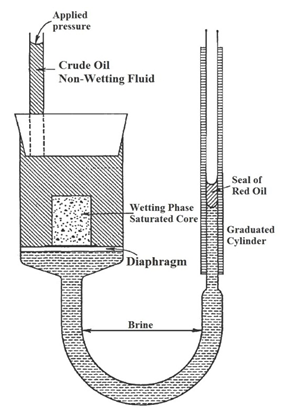Fundamentals of Fluid Flow in Porous Media
Chapter 2
Multi-phase Saturated Rock Properties:
Laboratory Measurement of Capillary Pressure: Porous Diaphragm Method
The essential requirement of this method is a permeable membrane of uniform pore size distribution containing pore of such size that the selected displacing fluid will not penetrate the diaphragm when the pressure applied to the displacing phase are below some selected maximum pressure of investigation. Various materials such as fritted glass, porcelain, and cellophane could be used as diaphragm in this test. The membrane is saturated with the fluid to be displaced (Wetting phase). Any combination of the fluids can be used: gas, oil and/or water. In the gas-water system, gas is the non-wetting phase and water is wetting phase. Air is used as the gas fluid sample commonly. As the first step saturate the core sample with wetting phase (water here), then placing the core on a porous membrane which is saturated 100% with water and is permeable to the water only, under the pressure drops imposed during the experiment. Air is then admitted into the core chamber and the pressure is increased until a small amount of water is displaced through the porous, semi-permeable membrane into the graduated cylinder. Pressure is held constant until no more water is displaced, which may require several days or even several weeks. By measuring the exited water volume and using rock pore volume, saturation change in each step could be calculated:

At each step the applied pressure is actually the capillary pressure which was defined as non-wetting phase pressure (nitrogen applied pressure here) minus wetting phase pressure (water pressure equal to zero), so the pressure data can be plotted as capillary pressure data versus wetting phase (water) saturation. Figure 2‑56 shows schematically porous diaphragm capillary pressure device.
Complete determination curve of capillary pressure with this method is time consuming owning to the vanishing pressure differentials causing flow as the core approaches equilibrium at each imposed pressure. Time to reach the equilibrium increases step by step because of the reduction of displaced fluid relative permeability as a result of saturation decrease. Most determinations of capillary pressure by this method are drainage tests. If you have any questions at all, please feel free to ask PERM! We are here to help the community.
Figure 2-56: Porous Diaphragm Capillary Pressure DeviceReferences
Questions?
